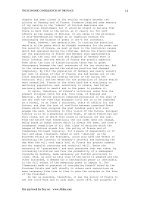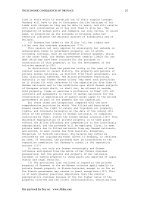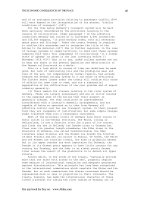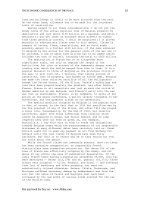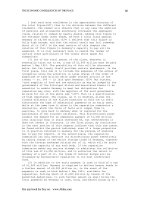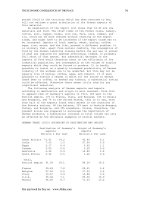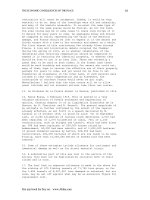The economic psychology of incentives new design principles for executive pay
Bạn đang xem bản rút gọn của tài liệu. Xem và tải ngay bản đầy đủ của tài liệu tại đây (1.96 MB, 192 trang )
The Economic Psychology of Incentives
The Economic Psychology
of Incentives
New Design Principles for Executive Pay
Alexander Pepper
London School of Economics and Political Science, UK
© Alexander Pepper 2015
Softcover reprint of the hardcover 1st edition 2015 978-1-137-40923-2
All rights reserved. No reproduction, copy or transmission of this
publication may be made without written permission.
No portion of this publication may be reproduced, copied or transmitted
save with written permission or in accordance with the provisions of the
Copyright, Designs and Patents Act 1988, or under the terms of any licence
permitting limited copying issued by the Copyright Licensing Agency,
Saffron House, 6–10 Kirby Street, London EC1N 8TS.
Any person who does any unauthorized act in relation to this publication
may be liable to criminal prosecution and civil claims for damages.
The author has asserted his right to be identified as the author of this
work in accordance with the Copyright, Designs and Patents Act 1988.
First published 2015 by
PALGRAVE MACMILLAN
Palgrave Macmillan in the UK is an imprint of Macmillan Publishers Limited,
registered in England, company number 785998, of Houndmills, Basingstoke,
Hampshire RG21 6XS.
Palgrave Macmillan in the US is a division of St Martin’s Press LLC,
175 Fifth Avenue, New York, NY 10010.
Palgrave Macmillan is the global academic imprint of the above companies
and has companies and representatives throughout the world.
Palgrave® and Macmillan® are registered trademarks in the United States,
the United Kingdom, Europe and other countries.
ISBN 978-1-349-68142-6
ISBN 978-1-137-40925-6 (eBook)
DOI 10.1007/978-1-137-40925-6
This book is printed on paper suitable for recycling and made from fully
managed and sustained forest sources. Logging, pulping and manufacturing
processes are expected to conform to the environmental regulations of the
country of origin.
A catalogue record for this book is available from the British Library.
A catalog record for this book is available from the Library of Congress.
Contents
List of Tables and Figures
vi
Preface and Acknowledgements
vii
1 Introduction
1
2 Long-Term Incentive Plans
10
3 Behavioural Agency Theory
26
4 Risk, Uncertainty and Time Discounting
59
5 Intrinsic Motivation and the Crowding-Out Conjecture
86
6 Fairness as a Precondition for Profit Seeking
105
7 New Design Principles for Executive Pay
129
Appendix 1: Questionnaire Used in the Main Study
144
Appendix 2: Main Study Demographics
149
Appendix 3: Mathematical Proof of the Importance of
Fairness in Teams
152
Future Research
154
Further Reading
157
References
160
Author Index
173
Subject Index
178
v
Tables and Figures
Tables
1.1 Definition of key terms
2.1 Key themes and exemplary quotes from the
preliminary study
3.1 Assumptions about the nature of man under positive
agency theory and behavioural agency theory
3.2 Overview of positive agency theory vs. behavioural
agency theory
4.1 Aggregate results of the main study
4.2 Country indices
4.3 Hofstede correlations
5.1 Work preference inventory – descriptive statistics and
one-sample t-test
5.2 Intrinsic motivation scores
6.1 Predicted results in the second fairness dilemma
6.2 Results of the ultimatum gain
6.3 Estimating coefficients for envy
6.4 Distribution of results in Dilemma 2
7.1 New design principles for executive pay
8
22
34
54
69
73
77
102
103
113
117
119
121
133
Figures
3.1
3.2
3.3
5.1
6.1
7.1
An agent’s job performance and work motivation cycle
Agents’ pay–effort curve
Firms’ performance cycle
Concepts of motivation
Distribution of the results of the ultimatum game
Summary and formal restatement of behavioural
agency theory
7.2 Remuneration committee’s dilemma
7.3 The process of institutional change
vi
48
49
52
95
115
131
137
141
Preface and Acknowledgements
The directors of such companies, however, being the managers rather of
other people’s money than of their own, it cannot well be expected, that
they should watch over it with the same anxious vigilance with which
the partners in a private copartnery frequently watch over their own.
Like the steward of a rich man they are apt to consider attention to small
matters as not for their master’s honour, and very easily give themselves
a dispensation from having it. Negligence and profusion, therefore, must
always prevail, more or less, in the management of the affairs of such a
company.
Adam Smith (1776) An inquiry into the nature and
causes of the wealth of nations. London: Strahan and
Cadell. Book V: Chapter 1: Part III. Article 1. “Of the
Public Works and Institutions Which Are Necessary
for Facilitating Particular Branches of Commerce”.
The pleasure which we are to enjoy in ten years hence, interests us so
little in comparison with that which we enjoy today, the passion which
the first excites, is naturally so weak in comparison with that violent
emotion which the second is apt to give occasion to, that one could
never be any balance to the other, unless it was supported by a sense of
propriety.
Adam Smith (1759) The theory of moral
sentiments. London: Miller; Edinburgh: Kincaid and
Bell. Part IV: Chapter 2. “Of the Beauty Which
the Appearance of Utility Bestows Upon
the Characters and Actions of Men”.
Adam Smith identified the agency problem in public corporations
as long ago as 1776 in the Wealth of Nations, the first great specialist work of economics. Yet Adam Smith was also a behavioural
scientist, writing in 1759 in The Theory of Moral Sentiments about
vii
viii Preface and Acknowledgements
motivation, loss aversion, fairness and inter-temporal choice, among
other things.1 That agency problems in public companies still exist
today, and that the kinds of incentive mechanisms advocated by
scholars and implemented by practitioners have not achieved their
objective of solving these problems, is surely not in dispute: even
John Roberts, one of the world’s leading organisational economists
and a well-known agency theorist, has commented that agency theory did not perform well during the financial crisis of 2008–10.2
Nevertheless, it would be unwise to insist that the principal–agent
model is now so fundamentally flawed that it should be rejected in
its entirety: agency theory comes from a long and highly reputable
scholarly tradition which has, over the last 40 years, influenced
management scholars and legal theorists, as well as economists.
The objective of this book is to propose a new version of agency
theory which is built on more robust assumptions about human
behaviour. It develops a line of thinking whose origins can be traced
back to an article written by Robert Wiseman and Luiz Gomez-Mejia
which was published in the Academy of Management Review in 1998.3
My hope is that, by extending the theory and providing empirical
evidence in its support, I might encourage other scholars to build on
the behavioural agency model and test it with new data. Ultimately,
of course, my goal is to have an effect on management practice and to
contribute new ideas about executive reward that business will support, which might also help to win back the confidence of the public
in public corporations and their managers. It would indeed be very
disappointing if “negligence and profusion” were always to prevail in
the management of the affairs of public companies.
This monograph brings together in one place the research I have
carried out during the past six years with various collaborators
and co-authors into what has become known as the “behavioural
aspects of senior executive reward systems”, commencing with my
doctoral thesis submitted under that title in part fulfilment of the
1
Ashraf, N., Camerer, C., & Loewenstein, G. (2005). Adam Smith, behavioral
economist. Journal of Economic Perspectives, 19(3), 131–145.
2
Roberts, J. (2010). Designing incentives in organizations. Journal of Institutional Economics, 6, 125–132.
3
Wiseman, R., & Gomez-Mejia, L. (1998). A behavioral agency model of
managerial risk taking. Academy of Management Review, 23(1), 133–153.
Preface and Acknowledgements
ix
requirements of the degree of Doctor of Business Administration
(DBA), awarded by the University of Surrey in 2011. Various parts of
this book have previously been published in academic journals and
are reproduced here with permission of the co-authors and publishers
of the respective journals.
Pepper, A., Gore, J., & Crossman, A. (2013). Are long-term incentive plans an effective and efficient way of motivating senior
executives? Human Resource Management Journal, 23(1), 36–51.
Reproduced with the permission of John Wiley & Sons.
Pepper, A., & Gore, J. (2014). The economic psychology of incentives – An international study of top managers. Journal of World
Business, 49(3), 289–464. Reproduced with the permission of
Elsevier.
Pepper, A., & Gore, J. (2012). Behavioral agency theory: New foundations for theorizing about executive compensation. Journal
of Management,
t dx.doi.org: 10.1177/0149206312461054. Reproduced with the permission of Sage Publications.
Pepper, A., Gosling, T., & Gore, J. (2015). Fairness, envy, guilt and
greed: Building equity considerations into agency theory. Human
Relations, dx.doi.org/:10.1177/0018726714554663. Reproduced
with the permission of Sage Publications.
Many people deserve recognition for their contribution to this
work, foremost the co-authors of the journal articles around which
the book is based, namely Julie Gore and Alf Crossman at Surrey Business School, University of Surrey, and Tom Gosling at
PricewaterhouseCoopers in London. Their contributions to the original articles are noted at the beginning of the relevant chapters.
Without their help and support this work would not have been
possible.
Numerous others have contributed directly or indirectly to this
book. In addition to my co-authors, these include Jon Terry, Sean
O’Hare and Gemma Carr at PricewaterhouseCoopers; Wida Amani,
Rebecca Campbell and Lori Peterson at the London School of Economics (LSE); Tony Dundon of Human Resource Management Journal;
Wayne Cascio of Journal of World Business; Patrick Wright of Journal
of Management; and Mathew Sheep of Human Relations, along with
eight anonymous reviewers.
x
Preface and Acknowledgements
I am especially grateful to Julie Gore of the Surrey Business School,
who originally became involved in this work as the supervisor of
my DBA thesis, and who subsequently became my researcher collaborator and co-author. Julie has also been my academic mentor,
and her guidance and support as I went through a career change
from consultant to academic have been of great importance to me.
I also owe a great deal to the Foundation for Management Education,
and especially its director Mike Jones, who supported my move from
PricewaterhouseCoopers to LSE in 2008, and to Saul Estrin at LSE for
taking a risk and taking me on. This book is dedicated to them.
1
Introduction
Agency theory has been a major component of the economic theory
of the firm since the 1970s. It has also come to dominate academic
thinking about executive reward. Agency theory asserts that the interests of shareholders (who, for these purposes, are the principals in the
principal–agent relationship) and top managers (their agents) are different, and at times radically diverge. In order to align the interests
of principals and their agents, boards of directors, acting on behalf
of shareholders, create incentive contracts which reward executives
financially if shareholders’ returns increase, but not otherwise; or so
the theory goes. Agency theory also postulates the active monitoring of the actions of top managers by shareholders through a process
which we now know as corporate governance.
The main thesis of this book is that standard agency theory is
flawed, so that it is neither a good positive theory of senior executive
reward (it does not explain what actually happens) nor a good normative theory (it does not provide helpful guidance as to what should
happen). The book explores what happens if the behavioural assumptions on which agency theory is based are modified and brought
more closely in line with actual behaviour.
Standard agency theory assumes that firms are profit seeking, that
agents are both rational and rent seeking and that there is no nonpecuniary agent motivation. An agent’s utility is assumed to be
positively contingent on pecuniary incentives and negatively contingent on effort, and effort is assumed to increase monotonically
with additional reward. In practice we know that these things are
at best partial truths: not all firms are profit seeking all of the time;
1
2
The Economic Psychology of Incentives
some firms are sometimes focused only on survival; some firms have
a social purpose; some firms recognise a wider group of stakeholders
other than shareholders. Human agents are, in the words of Herbert
Simon, “boundedly rational” rather than fully rational:1 we estimate;
we take mental shortcuts in calculations; we make mistakes; we forget
things; we use language in ways which are far from clear.2 Motivation
is also a far more complex psychological phenomenon than standard
agency theory admits. We are motivated by many things other than
money: by doing a good job; the pleasure of giving; friendship; love;
duty; religious belief. The relationship between intrinsic motivation,
doing something for its own sake, and extrinsic motivation, doing
something for reward, is not straightforward. Some experts believe
that in certain circumstances increasing financial rewards “crowds
out” intrinsic motivation.3
Economists have long argued that the lack of realism in some of
their assumptions does not in itself undermine the scientific validity of their theories. Milton Friedman famously wrote that the test of
a good economic theory is its ability to predict future outcomes, not
any correspondence between its assumptions and mechanisms on the
one hand, and reality on the other.4 This principle has become institutionalised in standard neoclassical economic thinking, although it
increasingly seems rather odd: it is hard to imagine a natural scientist
1
Simon (1945/1997).
There are many different definitions of “bounded rationality”. As well as
Herbert Simon, I have been heavily influenced by Oliver Williamson, who
explains that rationality is subject to neuro-physiological rate and storage limits on the powers of agents to receive, store, retrieve and process information
without error (Williamson 1975, p.21). Williamson also talks about a further
element of bounded rationality, which he calls “language limits”, being the
constraints on individuals to communicate comprehensively in such a way
that they are fully understood by others, but this element is not really relevant
to the current article. Foss (2010) provides an elegant summary description of
bounded rationality, which he describes in terms of limitations in the human
capacity to process information and attempts to economise on mental effort
by relying on shortcuts or heuristics, and as a consequence of the fact that
cognition and judgement are subject to a wide range of biases and errors.
3
The most notable proponent of this view is Bruno Frey, a Swiss economist,
formerly Professor of Economics at the University of Zurich, and most recently
Professor of Economics at Zeppelin University, Friedrichshafen, Germany.
4
Friedman (1953/2008).
2
Introduction
3
trying to advance a similar argument. When it comes to agency
theory, however, we need not dwell on the merits or otherwise of
Friedman’s argument because there is a further problem.
The origins of agency theory lie in a series of theoretical papers
published in the 1970s.5 In 1990, empirical work by Michael Jensen
and Kevin Murphy, both agency theorists, failed to establish a conclusive link between CEO pay and stock price performance.6 This caused
a number of scholars to argue that companies would perform better if executives were provided with greater financial incentives, yet
the logical flaw and sleight of hand here should be apparent. The
principal–agent framework, which had begun as a positive theory
about executive compensation (i.e., seeking to explain what happened in practice) was being turned instead into a normative theory
(i.e., recommending what should happen) when the explanatory
powers of the model were found to be wanting. Ten years after Jensen
and Murphy’s empirical findings were reported, a meta-analysis of
over a hundred empirical studies concluded that incentive alignment
as an explanatory agency construct for CEO pay was at best weakly
supported by the evidence.7 A subsequent literature review suggests
that agency theory has apparently fared no better in later empirical research.8 We are driven to the conclusion that, when it comes
to executive compensation and behaviours, agency theory is not a
good predictor of outcomes, as well as being based on unrealistic
assumptions.
In recent years Milton Friedman’s principle has been challenged
by a number of behavioural economists and economic psychologists.
Many trace the origins of this schools of thought to the publication of a seminal article by Daniel Kahneman and Amos Tversky
in 1979 entitled “Prospect theory: an analysis of decisions under
risk”,9 although arguably the roots of behavioural economics can be
traced further back to Herbert Simon’s work on bounded rationality,
Harvey Leibenstein’s work on x-efficiency and even to the American
5
Spence & Zeckhauser (1971), Alchian and Demsetz (1972), Ross (1973) and
Jensen and Meckling (1976).
6
Jensen & Murphy (1990).
7
Tosi et al. (2000).
8
See Frydman & Jenter (2010).
9
Kahneman & Tversky (1979).
4
The Economic Psychology of Incentives
institutional economists writing at the end of the 19th and beginning
of the 20th centuries.10 Intriguingly both Kahneman and Simon won
the Nobel Prize in Economic Sciences for their work on the foundations of behavioural economics, even though neither of them would
have described themselves as “economists”.11
Behavioural economics is seen by some as a heterodox, even
heretical, activity, which is not worthy of association with standard
economic science, but this is increasingly an extreme view. Many
behavioural economists are trying to integrate their work with the
mainstream neoclassical tradition, in order to strengthen and enrich
it. Matthew Rabin argues that behavioural economics is increasingly
becoming “normal science”, in the sense in which that phrase is used
by Thomas Kuhn in The structure of scientific revolutions.12 That position is entirely consistent with the thesis of this book, that if the
behavioural assumptions of agency theory are modified and made
more consistent with actual observed behaviour, then a new set of
predictions can be inferred by deduction. These can be tested empirically with, it is further believed, a better chance of being shown to
be in accordance with the observable facts. The result is, arguably, a
better (behavioural) agency theory, with greater explanatory power
and more valuable applications for management practice.
The research
The research described in the following chapters took place during
the period 2008–13. It was provoked by general disquiet about how
10
Leibenstein (1966) argued that work motivation had to be taken into
account when determining the efficiency of labour. A history of the American
institutionalists is provided by Rutherford (2011).
11
Simon won the Nobel Prize in Economic Sciences in 1978 for “pioneering
research into the decision-making process within economic organizations”.
Kahneman’s Nobel Prize was awarded in 2002 “for having integrated insights
from psychological research into economic science, especially concerning
human judgment and decision-making under uncertainty”. Tversky was not
eligible for the prize because of his premature death in 1996.
12
Kuhn (1962/1996). Matthew Rabin made the remarks about normal science at a seminar delivered at the London School of Economics and Political
Science in February 2011.
Introduction
5
successful long-term incentive plans (LTIPs) were proving to be in
meeting their two primary objectives of aligning the interests of
shareholders and senior executives, and of motivating executives.
Criticisms included the assertion that complex designs made LTIPs
very hard to understand (objections by executives and investors),
performance targets were perceived to be undemanding (objections by investors) or too demanding (objections by executives),
the performance of comparator companies had an undue impact
on performance targets (executives) and the total amounts ultimately paid out were often perceived to be too high (some investors
and the public generally). One of the paradoxes about LTIPs is
that, self-evidently, all these points of view could not be easily
reconciled.
The research began with an exploratory study, which was described
in an article published in the journal Human Resource Management in
January 2013, and which forms the basis of Chapter 2. This first article was followed by a more rigorous working-out of the theoretical
implications of the revised set of assumptions about agent behaviour
in a theoretical paper, which was published in the Journal of Management in 2012, and which forms the basis of Chapter 3. The ideas
in Chapters 2 and 3 also owe much to the thesis which I submitted in part fulfilment of the requirements of the degree of Doctor of
Business Administration at the University of Surrey in 2010.
An aside here, which I hope will explain the motivation behind
this book and the way it has been framed. I am a late entrant to
academia. Between 1981, when I left university for the first time, and
2008 I worked for PricewaterhouseCoopers (PwC; formerly Coopers &
Lybrand) as an accountant, tax adviser and latterly as an HR consultant. Much of my time was spent advising companies on executive
reward strategies and LTIPs. Accounting and tax law are essentially
closed systems – decisions, and hence advice about decisions, are
largely based on the interpretation of written codes. Reward strategies, on the other hand, are open systems, and best practices in pay
design are informed by theories drawn from a wide range of academic
disciplines, by empirical work, by prior experience and sometimes by
original thinking. Given the open-ended nature of the issues I found
myself facing as an adviser to companies on reward, I turned to
the academic literature for ideas. The literature on executive reward
6
The Economic Psychology of Incentives
is extensive, and written in many traditions, including economics,
social psychology and management. I became increasingly fascinated
by this literature, prompting me to go back to university to undertake
a part-time doctorate at Surrey, and eventually, when the opportunity
unexpectedly arose, to leave PwC altogether to take up an academic
position at the London School of Economics. At the same time as
I made this move, I was also becoming aware that the academic study
of management, and management practice, often proceed in parallel
universes. Unlike medicine and law, management practitioners generally carry out their activities without any recourse to the academic
thinking which may be relevant to the decisions they are making.
Equally, management academics spend far too much time studying
phenomena that are not central to the day-to-day problems faced by
practising managers. The result is a missed set of opportunities on
both sides. Hence I decided to make building bridges between the
study of management in academia and the practice of management
one of the objectives of the latter part of my career.
That objective informs this book in a number of ways. I believe
that more management research should be made relevant and accessible to practitioners: too often good ideas are buried in technical
papers published in journals read only by other academics. At the
same time, I have developed a dislike of the type of intellectually
pre-digested practitioner material written by some academics, to be
found particularly in bookshops in airport terminals. There are lots
of highly intelligent business people, indeed many who might have
been academics themselves had they chosen a different path earlier
in their careers, who are perfectly capable of understanding complex
social scientific ideas. This book is intended for them, as well as for
academics and management students. While I have endeavoured to
avoid unnecessary academic language and have included some of
the more esoteric material in footnotes, equally I have not tried to
simplify the text unduly.
To return to the agenda of the book – after completing the work
that underpins Chapters 2 and 3, I was fortunate enough to attract
the interest of some of my former colleagues in the Reward group
at PwC. They agreed to support my research programme by providing funding for a research agency, Forbes Intelligence, to issue an
electronic version of my survey instrument, which had been developed for the earlier study, to a panel of international executives,
Introduction
7
thus helping to construct a unique and extremely rich dataset. The
empirical findings of this larger study were published in 2012 in a
PwC report entitled “Making executive pay work – the psychology
of incentives”,13 and subsequently in two other academic journal
articles.14 These two articles form the basis of Chapters 4 and 6.
Chapter 5, which examines intrinsic and extrinsic motivation, and
the “crowding-out” conjecture, is also based on the research carried
out in conjunction with PwC and Forbes Intelligence, but has not
previously been published. Empirical evidence for the crowding-out
conjecture in the context of executive pay falls short of an adequate scientific proof, even though the conjecture is intellectually
persuasive and consistent with other empirical research. Chapter 5,
therefore, summarises the relevant literature, provides some relevant
data from the study and makes a partial case in support of the conjecture, but for the time being it must be left to the reader to decide
on the merits of the argument. Chapter 6 examines the importance
of social comparisons in the determination of top pay, arguing that
senior executives have similar concerns about fairness as other workers. As a result, equity within teams becomes an important factor
in the design of top-management pay systems in contradiction, for
example, to one of the postulates of tournament theory. I argue, with
the support of my co-authors, that low-powered team-based incentives may actually be more effective than high-powered individually
based incentives. Chapter 7 draws the various threads together and
sets out the strengths of the various studies, as well as the overall limitations and areas for further investigation. Importantly, this chapter
also sums up the practical significance of the research, in particular
the implications for the future design of management incentives.
How to read this book
Readers will notice that this book describes what in one sense appears
to be a paradigmatic social science research programme, beginning
with an exploratory study, using this for theory construction, before
13
PwC (2012). “Making executive pay work – the psychology of incentives”. />14
Pepper & Gore (2014), Pepper et al. (2015).
8
The Economic Psychology of Incentives
testing the theory empirically in a large-scale quantitative study. This
description disguises the fact that the research was not necessarily
planned as carefully in advance as this description might suggest.
It progressed by evolution as much as by design. Such is the nature
of much social scientific research.
The book can therefore be read as the story of a social science
research project, starting with a preliminary study, followed by the
development of a full theoretical framework, then a more extensive empirical study and so on. Alternatively, because a number of
the chapters are based on articles published previously in academic
journals, most chapters are largely self-standing. Thus, it is perfectly
possible for the reader to dip in and out of the book, or to read the
chapters in non-sequential order.
Key definitions
The argument in the book is built upon a number of important definitions, including terms such as “efficiency”, “effectiveness”, “bounded
rationality”, “senior executive” and “top-management team”. These
terms are defined at the most appropriate point in the development of the argument; however, for the reader’s convenience key
definitions are summarised here in Table 1.1.
Table 1.1 Definition of key terms
Term
Definition
Bounded
rationality
A view of human rationality, first described by Herbert
Simon, which recognises that there are limitations in the
human capacity to process information; that we attempt
to economise on mental effort by relying on shortcuts or
heuristics; and that cognition and judgement are subject
to a wide range of biases and errors.
Efficiency and
effectiveness
An action, event, plan, policy or programme is
considered to be efficient if it causes inputs to be
minimised for a given set of outputs or outputs
maximised for a given set of inputs; on the other hand,
an action, event, plan, policy or programme is
considered to be effective if it is capable of achieving its
intended objectives, what the objectives are being
exogenous to the theory.
Introduction
9
Long-term
incentives
Long-term incentives include share-based incentives
such as stock options, restricted stock and performance
shares, as well as equity-linked cash-based incentives
such as phantom options and stock appreciation rights.
In the UK LTIPs typically take the form of an award of
deferred shares which vest over a three-year period
conditional upon the satisfactory achievement of a
number of financial performance targets.
Senior executive
The top managers of a firm who through their actions
are capable of affecting the company’s profits, share
price, reputation and market positioning.
Top-management
team
The group of very senior executives who are responsible
for defining and executing a firm’s strategy. This group,
which includes the chief executive officer (CEO), the
chief operating officer (COO), the chief financial officer
(CFO), divisional heads and other heads of function, is
sometimes referred to as the “management board”,
“operating board”, “executive committee” or “general
management committee”.
A note on referencing
Social scientists typically include extensive references to prior academic literature in the main text of their work as a way of building
their intellectual case. While this is an important part of validating
theoretical claims, it does not always make easy reading. In this book,
therefore, I have as far as possible consigned references to footnotes.
I prefer these to endnotes for ease of accessibility, to avoid the reader
having to scrabble back and forth between different pages, which was
hard enough to do even before the advent of e-books.
2
Long-Term Incentive Plans
In 1995 the Greenbury report1 recommended that UK companies
should adopt performance-related long-term incentive plans (often
known simply as “LTIPs”) for senior executives, preferring them to
traditional share options. The report pointed out that stock options
had a number of shortcomings: they sometimes led to windfall gains
simply as a result of general movements in share prices and did not
encourage directors to build up significant shareholdings in their
employing companies. Reuters Group plc was the first UK listed
company to adopt the new style of LTIP in 1993. Many other UK companies followed suit after 1995, influenced by the Greenbury report
as well as the withdrawal of tax relief for share options granted over
shares with a market value in excess of £20,000 in the 1995 budget.
Since that time, LTIPs have become a major component of senior
executive reward systems in UK listed companies. By 2012 long-term
incentives comprised nearly 50% of the total earnings of executives
in the FTSE 350, up from just under 40% in 2006.2
While designs vary, in the UK long-term incentives typically take
the form of an award of deferred shares which vest over a three-year
Parts of this chapter were previously published as Pepper, A., Gore, J., &
Crossman, A. (2013). Are long-term incentive plans an effective and efficient
way of motivating senior executives? Human Resource Management Journal,
23(1), 36–51, and are reproduced here with the permission of John Wiley and
Sons, and of my co-authors.
1
Greenbury, R. (1995). Director’s remuneration: Report of a study group chaired by
Sir Richard Greenbury. London: Confederation of British Industry.
2
Based on data obtained from Income Data Services (“The director’s pay
report” 2006 and 2013). London: Thomson Reuters.
10
Long-Term Incentive Plans
11
period conditional upon the satisfactory achievement of a number
of financial performance targets. These are often relative measures,
benchmarked against either an index or the financial performance
of a number of comparator companies, so that the extent to which
awards vest is dependent upon a company’s financial performance
relative to the market.
Long-term incentives have two primary objectives: first, to align
the interests of executives and shareholders in order to minimise
both agency risk and the associated agency costs (the alignment
objective); secondly, to recruit, retain and motivate senior executives to maximise their effort and give high performance (the
motivation objective). For some years there has been disquiet about
how successful LTIPs are in meeting these two objectives. Criticisms by executives, investors or the public generally include: the
assertion that complex designs make LTIPs very hard to understand; performance targets are perceived to be undemanding, or too
demanding; the performance of comparator companies has an undue
impact on performance targets; and the total amounts ultimately
paid out are perceived to be too high. One of the paradoxes about
LTIPs is that self-evidently these points of view cannot be easily
reconciled.
This chapter examines whether LTIPs are an effective and efficient3
way of motivating senior executives, while at the same time exploring other behavioural aspects of senior executive reward systems.
It argues that it is short-sighted to focus on the alignment objective
without also considering the motivation objective, on the basis that
the interests of shareholders and executives cannot be aligned if executives are not properly motivated to maximise their effort and give
high performance. It proposes that more attention should be paid to
the motivation objective and inequity aversion by economists and
other management theorists.
The rest of the chapter is organised as follows. It describes a qualitative research study which was designed, on an essentially inductive
3
For the purposes of this chapter, something is considered to be “efficient”
if it causes inputs to be minimised for a given level of output and “effective”
if it is capable of achieving its intended objectives. There is a strong logical
connection between the two terms. A more detailed explanation is provided
at the start of Chapter 3.
12
The Economic Psychology of Incentives
basis, to identify major research themes. It introduces the theoretical
framework, focusing on agency theory and work motivation, and sets
out three hypotheses. The methodology and findings of the study are
described and discussed. The chapter concludes by considering the
implications of the findings for the development of agency theory as
it applies to senior executive reward.
Agency theory
The investigations described in this chapter take agency theory as
their starting point on the basis that, as indicated in Chapter 1, it is
the dominant framework for examining senior executive reward,4 but
we examine a number of the underlying behavioural assumptions,
specifically those relating to motivation and fairness. Agency theory
focuses on the separation of ownership and control and hence on the
importance of incentive contracts to align the interests of shareholders and managers. The underlying assumptions are that organisations
are profit seeking, that agents are both rational and rent seeking, and
that there is no non-pecuniary agent motivation. It is assumed that
an agent’s utility is positively contingent on pecuniary incentives and
negatively contingent on effort. It is postulated that effort and motivation increase monotonically with additional reward. The pay–effort
function is therefore presumed to be a straight line with a positive
gradient proceeding from bottom left to top right.
The principal–agent model places less emphasis on the objective
of motivating agents (whether extrinsically or intrinsically) than
it does on alignment. David Kreps contends that it is not necessary to postulate the concept of intrinsic motivation on the basis
that what is called intrinsic motivation may in fact be no more
than a series of vaguely defined extrinsic motivators.5 Besley and
Ghatak argue that there is such a thing as a “motivated agent” whose
economic behaviour is affected by intrinsic motivation, but their
argument is restricted to employees of public sector or non-profit
4
See William Bratton’s article “The academic tournament over executive compensation” (2005) for an analysis of the comparative merits of agency theory
and the managerial power hypothesis advanced by Bebchuk, Fried & Walker
(2002).
5
Kreps (1997).
Long-Term Incentive Plans
13
organisations whose activities coalesce around a “mission”.6 Deci and
Ryan argue that the importance of intrinsic motivation should not be
underestimated.7 They challenge the idea that intrinsic and extrinsic motivation are either independent or additive, arguing instead
that contingent monetary rewards might actually cause a reduction
in intrinsic motivation. In a similar way, Frey and Jegen postulate
that in some cases extrinsic motivation can “crowd-out” intrinsic
motivation, particularly if monetary incentives are badly designed.8
They argue for a strong form of crowding-out, whereby an increase
in extrinsic reward leads to an overall reduction in total motivation. A weaker form of crowding-out can alternatively be postulated,
whereby the level of total motivation is maintained only if the
increase in extrinsic reward more than compensates for the reduction
in intrinsic motivation. Weak crowding-out is consistent with the
economic concept of the diminishing marginal utility of increasing
wealth.
The theory of work motivation most commonly used in investigations into the motivational impact of pay and monetary incentives
is expectancy theory. In the 1960s, the American psychologist Victor
Vroom turned an economic theory of rational choice (expected utility
theory) into a psychological theory of motivation (expectancy theory).9 Steel and König propose a version of expectancy theory called
“temporal motivation theory”, which combines expectancy theory
with hyperbolic discounting and prospect theory.10 Temporal motivation theory postulates that the motivation of a person to carry out act
i is the product of his expectancy that act i will lead to outcome k, via
j, and the value which he attaches to k, discounted for any time delay
between the occurrence of act i and outcome k. Therefore, motivation
6
Besley & Ghatak (2005).
Deci & Ryan (1985).
8
Frey & Jegen (2001).
9
Vroom proposes that motivation is a function of the subjectively perceived
probability that an agent’s actions will lead to a particular outcome, and the
value which the agent places on that outcome (Vroom 1964).
10
Temporal motivation theory is put forward by Steel & König (2006). Hyperbolic discounting was first proposed by Ainslie (1991) and Ainslie & Haslam
(1992). Kahneman & Tversky’s article: “Prospect theory – an analysis of
decision under risk” was published in 1979.
7
14
The Economic Psychology of Incentives
can be understood in terms of expectancy and value, weakened by
delay, with differences for gains and perceived losses.
Based on this theoretical analysis two hypotheses are advanced:
Hypothesis 1: Long-term incentives are systematically undervalued by senior executives because of the way that risk, value
and probability are subjectively assessed, the way that the value of
future reward is discounted, and as a result of cognitive responses
to uncertainty.
Hypothesis 2: Above an upper threshold level of earnings, extrinsic
reward weakly crowds-out senior executives’ intrinsic motivation.
A third hypothesis is derived from the literature examining the
relationship between pay and fairness. It is common ground that an
individual’s satisfaction with their earnings depends not just upon
buying power, but also on how their earnings compare with the
total rewards of salient others.11 Akerlof and Yellen postulate the
fair-wage effort hypothesis, according to which workers have a conception of a “fair wage” and if actual earnings are less than the fair
wage then only a corresponding fraction of normal effort will be supplied.12 According to John Stacey Adams people seek a fair balance
between what they put into their jobs (including energy, commitment, intelligence and skill – collectively “inputs”) and what they
get out (including financial rewards, recognition and opportunities
for personal growth – collectively “outputs”).13 People form perceptions of what constitutes a fair balance between inputs and outputs
by comparing their own situations with other referents. Referents
may be internal (peers, immediate subordinates, immediate superiors) or external (people doing equivalent jobs in other organisations).
If people feel that their inputs are fairly and adequately rewarded
by outputs, the equity benchmark being subjectively perceived from
market norms and other reference points, then they will be happy
in their work and motivated to keep contributing at the same (or
a higher) level. However, if the relationship between inputs and outputs is not proportionate, then the individual will become dissatisfied
11
Shafir, Diamond & Tversky (1997).
Akerlof (1982) and Akerlof & Yellen (1990).
13
Adams (1965).
12


